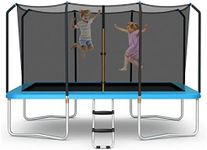Buying Guide for the Best Rectangular Trampolines
Choosing a rectangular trampoline can be a fun but important decision, especially if you want to ensure safety, durability, and the right fit for your space and needs. The key is to think about who will use the trampoline, where it will be placed, and what kind of activities you expect to do on it. By understanding the main features and how they relate to your situation, you can make a choice that will keep everyone happy and safe.SizeThe size of a rectangular trampoline refers to its length and width, which determines how much jumping space you have. This is important because a larger trampoline offers more room for tricks and multiple users, while a smaller one fits better in limited spaces. Sizes can range from compact (around 7x10 feet) to very large (over 10x17 feet). If you have a small yard or only one child using it, a smaller size may be best. For families, older kids, or those interested in gymnastics, a larger trampoline provides more versatility and safety.
Weight LimitThe weight limit tells you the maximum combined weight the trampoline can safely support. This is crucial for safety, as exceeding the limit can damage the trampoline or cause injuries. Weight limits can vary from around 200 pounds for smaller models to over 400 pounds for heavy-duty ones. If multiple people will use the trampoline at once, or if adults plan to jump, choose a model with a higher weight limit to ensure everyone stays safe.
Frame MaterialThe frame material is what gives the trampoline its strength and stability. Most frames are made from steel, but the thickness and type of steel can vary. A thicker, rust-resistant steel frame will last longer and handle more use, especially outdoors. If you want a trampoline that will last for years and withstand weather, look for strong, galvanized steel frames. For occasional or indoor use, lighter frames may be sufficient.
Spring Quality and CountSprings are what give the trampoline its bounce. The number and quality of springs affect how high and smoothly you can jump. More springs and longer, thicker springs usually mean a better, softer bounce, which is important for gymnasts or anyone wanting to do tricks. For young children or casual use, fewer or shorter springs may be fine. If you want a trampoline for advanced jumping or multiple users, prioritize models with more and higher-quality springs.
Safety EnclosureA safety enclosure is a net that surrounds the jumping area to prevent falls. This is especially important for children or inexperienced jumpers. Some trampolines come with high, tightly-woven enclosures, while others may have lower or looser nets. If safety is a top concern, look for a trampoline with a sturdy, well-attached enclosure that fully surrounds the jumping area and has a secure entrance.
Mat MaterialThe mat is the surface you jump on, and its material affects both comfort and durability. Most mats are made from polypropylene or similar synthetic fabrics, which are strong and weather-resistant. A thicker, UV-resistant mat will last longer and feel better to jump on, especially if the trampoline will be outdoors. If you expect heavy use or exposure to sun and rain, choose a mat with extra durability features.
Assembly and MaintenanceHow easy it is to assemble and maintain the trampoline can make a big difference in your experience. Some trampolines come with clear instructions and require only basic tools, while others may be more complex. If you prefer a hassle-free setup, look for models known for easy assembly. Also, consider how easy it is to clean and check for wear, especially if the trampoline will be outside year-round.












